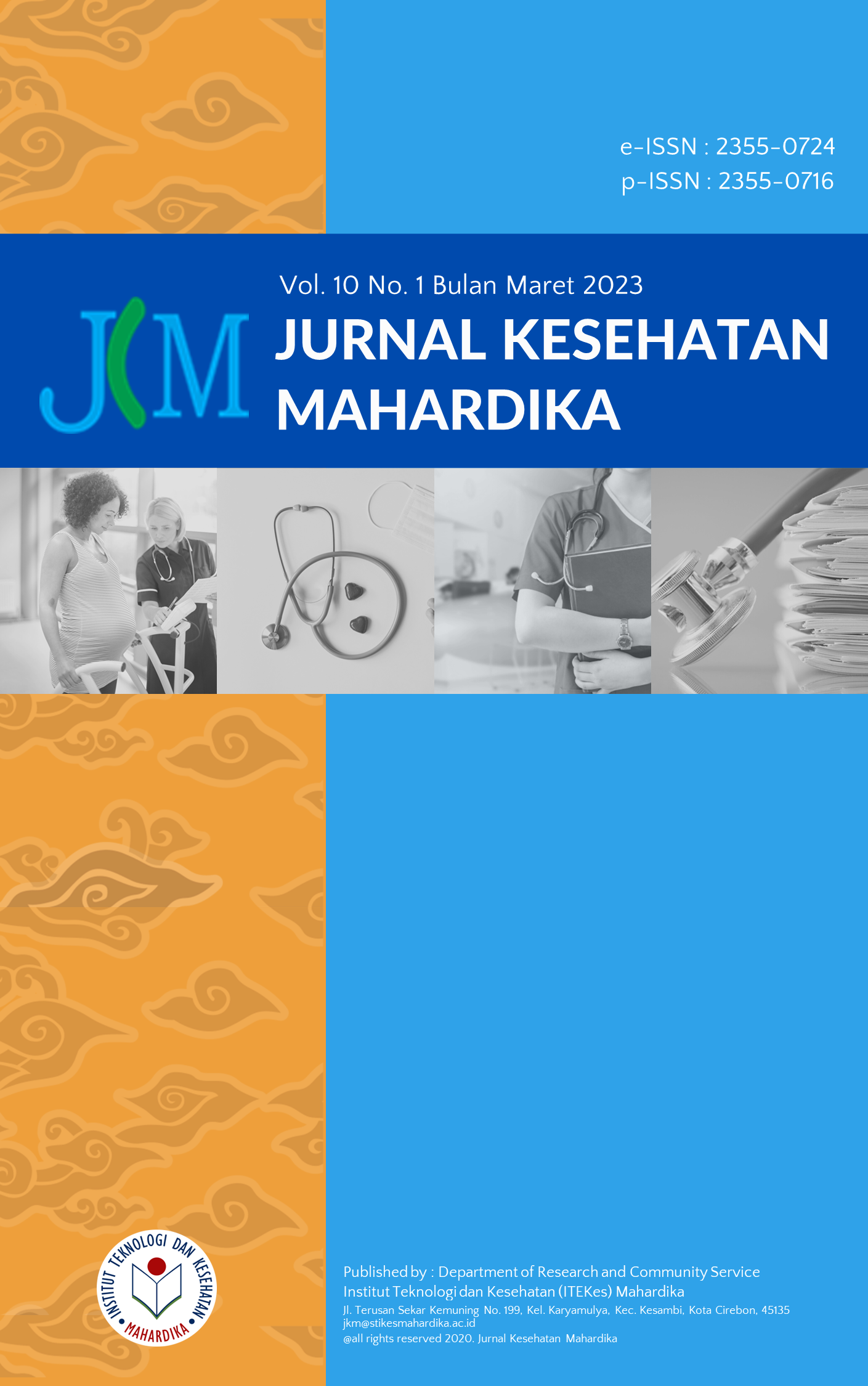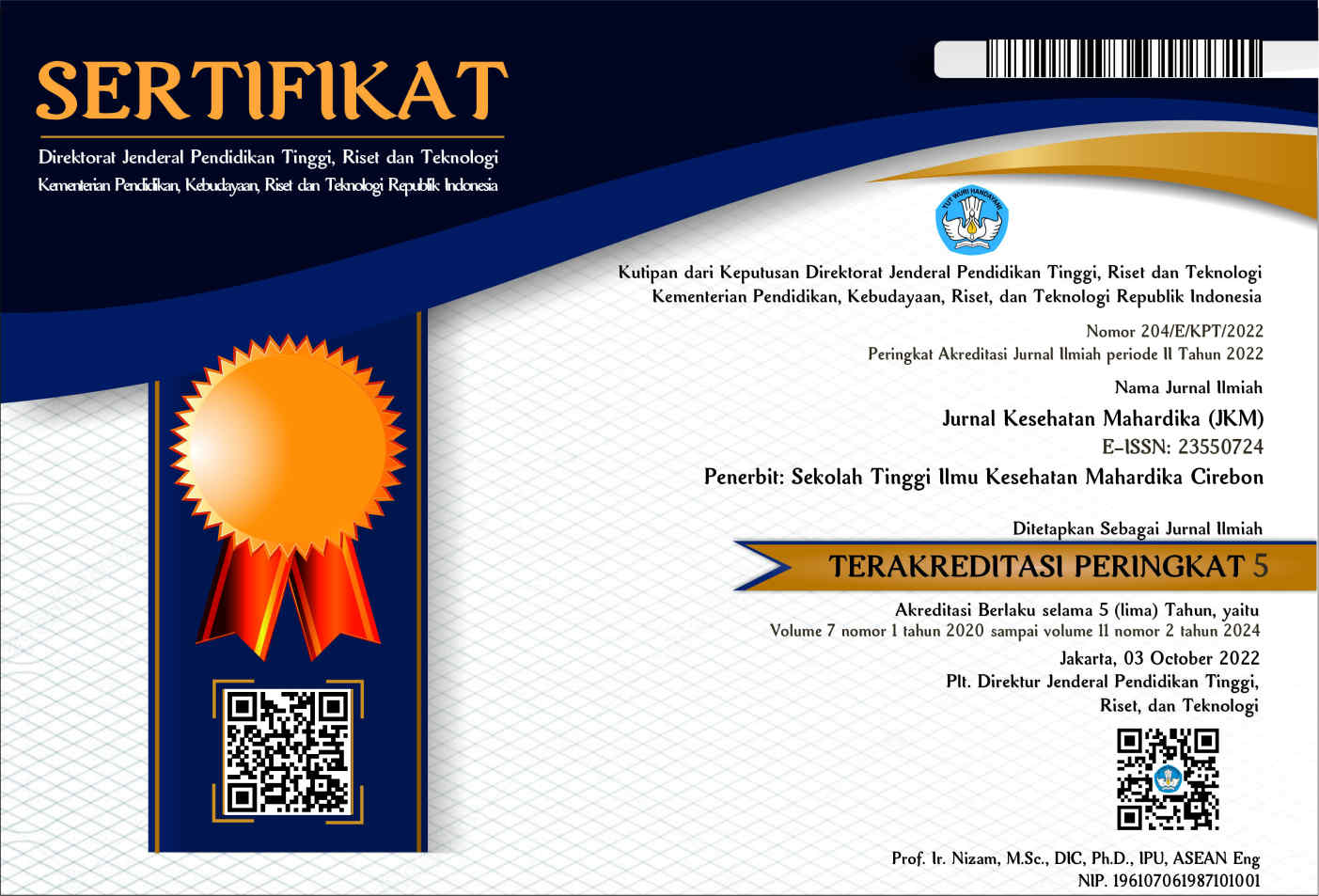Socio-Economic Relations with the Incidence of Stunting in the Cipadung Primary Health Center Bandung City
Keywords:
Stunting, Socioeconomic, ToddlersAbstract
Stunting toddlers in Bandung City were 25.8%. One of the causes is the low economy so that it cannot meet the nutritional needs of the family. This study aims to assess the socioeconomic relationship with stunting incidence. The type of research used is an analytical study with a cross-sectional design. The sample in this study was 108 respondents. The sampling technique used is simple random sampling. The instrument used is a questionnaire. Data analysis using chi square test. The results of the study found a relationship between socioeconomics and stunting incidence with a value of p = 0.029, POR = 2.653 (1.179-5.967). Families with socioeconomic conditions that include gakin are 2.6 times more likely to have stunting than socioeconomic ones who are non-gakin.
References
Aramico, B., Sudargo, T., Susilo, J., 2016. Hubungan sosial ekonomi, pola asuh, pola makan dengan stunting pada siswa sekolah dasar di Kecamatan Lut Tawar, Kabupaten Aceh Tengah. Jurnal Gizi dan Dietetik Indonesia (Indonesian Journal of Nutrition and Dietetics) 1, 121–130. https://doi.org/http://dx.doi.org/10.21927/ijnd.2013.1(3).121-130
Aritonang, E.A., Margawati, A., Dieny, F.F., 2020. Analisis pengeluaran pangan, ketahanan pangan dan asupan zat gizi anak bawah dua tahun (BADUTA) sebagai faktor risiko stunting. Journal of nutrition college 9, 71–80.
Aryastami, N.K., Shankar, A., Kusumawardani, N., Besral, B., Jahari, A.B., Achadi, E., 2017. Low birth weight was the most dominant predictor associated with stunting among children aged 12–23 months in Indonesia. BMC Nutr 3, 16.
Beal, T., Tumilowicz, A., Sutrisna, A., Izwardy, D., Neufeld, L.M., 2018. A review of child stunting determinants in Indonesia. Matern Child Nutr 14, e12617. https://doi.org/https://doi.org/10.1111/mcn.12617
Bening, S., Margawati, A., Rosidi, A., 2018. Asupan Zink, Riwayat ISPA dan Pengeluaran Pangan Sebagai Faktor Resiko Stunting Pada Anak Usia 2-5 tahun di Kota Semarang. Jurnal Gizi 7.
Black, R.E., Victora, C.G., Walker, S.P., Bhutta, Z.A., Christian, P., De Onis, M., Ezzati, M., Grantham-McGregor, S., Katz, J., Martorell, R., 2013. Maternal and child undernutrition and overweight in low-income and middle-income countries. The lancet 382, 427–451. https://doi.org/https://doi.org/10.1016/S0140-6736(13)60937-X
Cumming, O., Cairncross, S., 2016. Can water, sanitation and hygiene help eliminate stunting? Current evidence and policy implications. Matern Child Nutr 12, 91–105. https://doi.org/https://doi.org/10.1111/mcn.12258
Dinas Kesehatan Provinsi Jawa Barat, 2019. Profil Kesehatan Jawa Barat. J Chem Inf Model 53, p.21-25.
Gross, R., Schoeneberger, H., Pfeifer, H., Preuss, H.-J., 2000. The four dimensions of food and nutrition security: definitions and concepts. SCN News 20, 20–25.
Kasumayanti, E., Zurrahmi, Z.R., 2020. Hubungan Pendapatan Keluarga dengan Status Gizi Balita di Desa Tambang Wilayah Kerja Puskesmas Tambang Kabupaten Kampar Tahun 2019. Jurnal Ners 4, 7–12.
Kemenkes RI, 2018a. Situasi Balita Pendek (Stunting) di Indonesia. Kementrian Kesehatan Republik Indonesia 1–13.
Kemenkes RI, 2018b. Hasil utama RISKESDAS 2018. Kementrian Kesehatan Republik Indonesia 20.
Lestari, W., Margawati, A., Rahfiludin, Z., 2014. Faktor risiko stunting pada anak umur 6-24 bulan di kecamatan Penanggalan Kota Subulussalam Provinsi Aceh. Jurnal Gizi Indonesia (The Indonesian Journal of Nutrition) 3, 37–45. https://doi.org/https://doi.org/10.14710/jgi.3.1.126-134
Ngaisyah, R.D., 2015. Hubungan sosial ekonomi dengan kejadian stunting pada balita di Desa Kanigoro, Saptosari, Gunung Kidul. Medika Respati: Jurnal Ilmiah Kesehatan 10. https://doi.org/https://doi.org/10.35842/mr.v10i4.105
Organization, W.H., 2020. UNICEF/WHO/The World Bank Group joint child malnutrition estimates: levels and trends in child malnutrition: key findings of the 2020 edition.
Sutriyawan, A., 2021. Metodologi Penelitian Kedokteran dan Kesehatan: Dilengkapi Tuntunan Membuat Proposal Penelitian. Bandung: PT Refika Aditama.
Sutriyawan, A., Nadhira, C.C., 2020. Kejadian Stunting Pada Balita Di Upt Puskesmas Citarip Kota Bandung. Jurnal Kesmas (Kesehatan Masyarakat) Khatulistiwa 7, 79–88. https://doi.org/http://dx.doi.org/10.29406/jkmk.v7i2.2072
TNPPK, 2017. 100 kabupaten/kota prioritas untuk intervensi anak kerdil (stunting). Jakarta: Tim Nasional Percepatan Penanggulangan Kemiskinan.
Wamani, H., Åstrøm, A.N., Peterson, S., Tumwine, J.K., Tylleskär, T., 2007. Boys are more stunted than girls in sub-Saharan Africa: a meta-analysis of 16 demographic and health surveys. BMC Pediatr 7, 17.

Published
How to Cite
Issue
Section
Copyright (c) 2023 Jurnal Kesehatan Mahardika

This work is licensed under a Creative Commons Attribution-NoDerivatives 4.0 International License.












